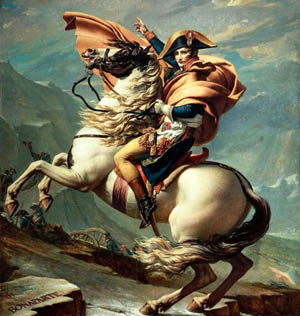Archive for the ‘Geography’ Category
Tsunamis
Posted on: April 25, 2011
On March 11, 2011, East Japan was hit by one of the most devastating tsunamis the world had ever seen,officially named the Great East Japan Tsunami. The world waited in despair as the people of Japan braced themselves for the tsunami triggered by a massive 9.0 earthquake, the most powerful to hit the country. When the wave finally came, cars, houses and whole buildings were instantly swept away. On that day itself, 17,000 people had gone missing, leaving 10,000 dead. But the worst was yet to come. Four nuclear plants in Fukushima Daiichi overheated when the tsunami killed the power lines, causing their coolers to stop working. Explosions soon followed, and then the radiation began to leak.
As far as tsunamis go, the actual size of the tsunami, which was 10 metres, was the not biggest ever, in fact, it was comparatively small. A tsunami in 1958 in Lituya Bay, Alaska, USA, for example, reached 524 metres. However, because it hit a fairly isolated area, very few people died. In contrast, 20,000 people died in the Great East Japan Tsunami at last count, which is again, fairly little compared to the Asian Tsunami of 2004 where 230,000 people died.
What marks the Great East Japan Tsunami as so uniquely tragic is the suffering that not only Japan, but the rest of the world will have to endure. Radiation has already been found in the rainwater that fell on Boston, USA. Seafood may now be radioactive because the amount of radioactive tap water in Japan has become simply too much for the resilient country to contain, and they have been forced to throw the contaminated water into the ocean.
And all because of a tsunami.
Tsunami is a Japanese word which literally translated means “harbour wave”. It is fitting that the Japanese named it because they have unfortunately been afflicted with 195 tsunamis. However, tsunamis have been endangering mankind since approximately 6100 BC, the year when the first tsunami was recorded in the Norwegian Sea.

A tsunami approaching a coast.
Tsunamis are a result of the earth’s continental plates shifting against each other. But it’s not as simple as that. If the plates just grind against each other as a strike-slip motion, a tsunami is not very likely. They only occur if there is vertical displacement. That is, when one of the crusts acts as a paddle, transferring the energy of the underwater earthquake to the other crust, creating a wave of water. This wave of water, which starts out harmless enough could be, by the end of its journey to the coast of an unfortunate land, up to 260m – like the tsunami in Spirit Lake, Washington, USA in 1980.

The wave of the Asian Tsunami of 2004.
Tsunamis are one of the most dangerous destroyers in the world. Some bright (and somewhat misguided) minds recognised that and picked up on the idea to use a tsunami as a weapon. In 1999, it was discovered that during World War II, in 1944 and 1945, scientists in Auckland were testing a tidal wave bomb. The American government in particular were supportive of the project, for if perfected, it could have been as deadly as a nuclear bomb. However, the project was scrapped when the man made tsunamis never got to a threatening enough size and theoretical flaws were found.
The destinies of nuclear power and tsunamis have long been intertwined. Today, tsunamis can be triggered by using nuclear power to create vertical displacement, though certainly not on the same scale as a natural tsunami. On May 11th 2011, their fates intertwined yet again, in a way that no one could have predicted. In Japan now, the plant workers are, at this moment, working to contain the radiation, with the fate of Fukushima and the rest of the world in their hands.
The Summer Solstice
Posted on: June 20, 2009
On 21st June 2009, the Earth will be at the closest distance to the sun than it has been the whole year. When the Earth is either at its furthest or closest distance from the sun, it is called a solstice. Solstices have the power to bring change and new energies.
As astronomers have found out, the Earth is tilted on an axis, and very slowly moves round the sun, at the same time that it spins around this axis. Astronomers such as Galileo, have also found that indeed, the sun and its solar system do not move around the Earth, but instead, the Earth is one of the many planets that circles the sun as the centre of the solar system.
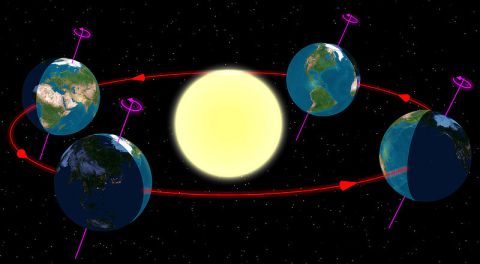
Far left: the Summer Solstice, Far right: the Winter Solstice, in between: Equinoxes
As you can imagine, the sun holds such power, that when a Solstice comes around, the Earth’s many inhabitants can feel the effects.
The sibling of a solstice, so to speak, is an Equinox. An Equinox happens when the sun is right in the middle of the Earth’s equator, and the Earth is neither leaning towards nor away from the sun.
Solstices happen twice a year, once in June – the summer one – and once in December – the winter one. The Summer Solstice occurs sometime between June 20 and June 21, and the Winter Solstice sometime between December 21 and December 22. The Summer Solstice is the longest day and the shortest night in the year. In turn, the Winter Solstice is the longest night but the shortest day in the year.
Humans have known about the relationship between the Earth and the sun since the very beginning, and have built monuments such as the Stonehenge to monitor the sun’s yearly progress.
Solstices are celebrated all over the world. There are the Dōngzhì festival in China, Christmas worldwide as well as the Summer Solstice celebrations in many Mediterranean countries.
In the Dōngzhì festival, which takes place around the Winter Solstice, Chinese families get together to eat yummy glutinous rice balls (Tāng Yuán) that represent family reunion and prosperity. Christmas, which also takes place around the time of the Winter Solstice, is not only a celebration of the birth of Jesus Christ, but also a celebration of the Winter Solstice.

The delicious Tāng Yuán (pronounced: Tong Yee-IRN).
Many Mediterranean countries dedicate the Summer Solstice to St. John the Baptist, and their rituals are very similar to the Celtic festival, Samhain.
The spiritual aspect of the solstices is change. It is said that with the Summer Solstice, tomorrow 21 June 2009, all of the old and murky will be swept away and the new will be brought in. Many people will feel the turmoil that this entails in the few months, weeks or days leading up to the solstice.
For example, a project that you’ve been trying to push for a long time is just not budging, and things are just not working out for you, but never fear, for when the Solstice comes, everything should become clear.
Scandinavia
Posted on: October 30, 2008
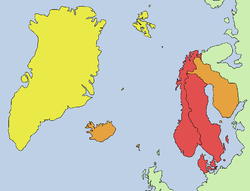
Red: the three monarchies that compose Scandinavia according to the strictest definition; Orange: the possible extended usage; Yellow: the maximal extended usage that takes Scandinavia as synonymous to the Nordic countries.
Wall Street is in tatters. Financial markets everywhere are falling. Many companies are on the brink of becoming bankrupt or already are, such as Lehman Brothers. But nothing is as terrifying as a whole country becoming bankrupt
Iceland has been battered by the current financial crisis. In October, I read that Iceland was on the brink of bankruptcy. And then Kaupthing, the country’s largest bank was nationalized by Iceland’s Financial Supervisory Authority a few days later.
Iceland is not just a block of ice near the North Pole, as one may have thought. No, it’s an entire country, a homeland to 301,931 people. Iceland is also a part of a region of Europe, called Scandinavia.
Scandinavia is a group of countries from which some big things have come. Among them, Ikea, the huge chain of furniture stores around the world; the Icelandic pop singer Björk, who made her debut in The Sugarcubes, an electronica group, and later, became a solo artist; Volvo, one of the safest cars on the market; and, the pop group ABBA.
As far as groups of countries go, Scandinavia – which today consists of Iceland, Norway, Finland, Sweden and Denmark – is a unique one. It was home to the Vikings from 793 – 1066 AD. They were as barbaric a people as any in the earlier centuries; they raided Saxon-England and killed many. You see, they were running out of land. If you were to fast forward about eight centuries, you would see that a Viking daughter would still not be able to inherit anything from her father when he died. Everything went to the sons.
It was a slightly different scenario for the Viking boys during 1000 AD. When a father died, only the eldest son inherited his land. The younger sons got nothing. Well, they needed land to build their houses, right? So, what did they do? The simple solution: steal foreign land. And since England is close to Scandinavia, why not start there?
Over in England, William of Normandy had discovered a whole group of countries that were – gasp – not his. He wanted to conquer Scandinavia and make it his own. Understandably, the Vikings did not welcome him with open arms. After an intense battle however, William of Normandy won, and that was the decline of Viking rule in Scandinavia.
But Scandinavia was not always a united group of countries. Fast-forward again eight centuries, to the time of the Napoleonic War (1803 – 1815) when Sweden and Denmark-Norway fought against each other.
This war was sparked by the French revolution and led by Napoleon Bonaparte. Denmark-Norway were, at that time in union under the same king and they tried to remain neutral. But they had to get involved once their navies were threatened by the British, and they consequently joined forces with Napoleon. Sweden, however, was very active from the start, and very much a part of the war. In 1813, they were promised Norway by the Coalition forces against Napoleon, for joining their Alliance against France.
On January 14, 1814, the king of Denmark-Norway signed the Treaty of Kiel, which gave Norway away to Sweden. However, the terms in the treaty were not acceptable to all and an opposition group led by Christian Frederik, an heir to the Denmark-Norway throne, was formed.
On May 17, 1814 the Constitution of Norway was signed by the opposition group, and Norway declared herself independent, with Christian Frederik as her king. The Swedish king did not accept the idea of an independent Norway, and a war followed from 27 July 1814 – August 14, 1814.
The short battles were won by the Swedish, and the Norwegian king conceded to a peace treaty, which required him to return to Denmark and give up his Norwegian throne provided Sweden accepts the democratic Norwegian constitution and a loose personal union. And so on November 4, 1814, the Norwegian Parliament entered into a union with Sweden.
During the First World War, all the countries in Scandinavia remained neutral; however, the war did have an effect on the economy. It took a hit on Scandinavia, as it did the rest of the world.
Coming back to the present, Scandinavia is today made up of five countries. Yes, five – Denmark, Norway, Sweden and usually, though not officially, Finland and Iceland.
Here’s some handy information on these five countries:

Denmark’s population of about 5.4 million speak Danish. Most of the people there have been baptized Protestant. In 2008, Copenhagen was declared the most livable city in the world by Monocle magazine! The winner’s citation read: “Copenhageners rejoice: your city (and its design) has our gold medal.”

In 2007 Norway had a population of about 4.6 million that spoke mostly Norwegian. However, in some districts, Sámi is an official language, too. The Nobel Peace Prize is presented in Oslo – the only Nobel Prize not to be awarded in Sweden.
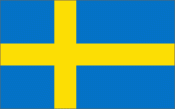
Sweden’s population of 9 million speak Swedish. The Nobel Prizes are presented in Stockholm, seeing as a Swedish man, Alfred Nobel established the Prizes. Sweden is heavily affected by winter. Every year in January; the city of Kiruna is blanketed in the darkness, and actually gets 0 hours of daylight!

Finland’s population of 5.3 million speak both Finnish and Swedish as their official languages. This bi-lingual country makes good use of its 1.8 million saunas. Also it has, 5.2 million mobile phones in use. Nokia, being a Finnish brand, probably had something to do with that.
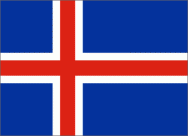
Iceland’s population of 301,931 speaks Icelandic and it is the least populated country in Europe. Despite Iceland’s name giving the impression that it is full of ice and no more, it’s chock-a-block with natural wonders. The midnight sun (apparently there is such a thing and it’s not just a title from the Twilight series) is an amazing light during the night in the summer.
If you wish to find out more about these fascinating countries, you can check out their websites:
Denmark – http://www.denmark.dk/en/
Norway – http://www.visitnorway.com/
Sweden – http://www.sweden.se/
Finland – http://www.visitfinland.com/
Iceland – http://www.icetourist.is/
I must say that the Finland website had the most interesting information, stating some of the unique statistics about Finland.
Scandinavia is very cold, being near the North Pole. Ranging from 5°C to -6°C in just the past few days, it was probably also one of the reasons the Vikings traveled to England, which although cold and rainy, is still warmer than Scandinavia.
Information on the Scandinavian countries from http://goscandinavia.about.com/.
Other info and pictures from www.wikipedia.com.
- In: Geography
- 5 Comments

Copyright: sundaysenergy.org
Hey guys. So we all know what going green is, right? It’s recycling. Saving electricity. All that jazz. What you probably didn’t know is that we only have 99 months to do just that: Stop global warming. And that’s if we’re lucky. Let’s do some calculations. 99 months = 8.3 years approx. Yeah. That means you may never get to have kids. Learn to drive. Go to college. Start a business. Fall in love.
Apparently, the arctic circle, is now, indeed, a circle. But a much smaller one. An island, in fact. If it breaks, we all, to put it simply, die. And so does our planet.
So, go to this website: http://www.onehundredmonths.org/ and see how you can help out.
For a start, there’s turning off your screen saver. And sending http://www.onehundredmonths.org/ to all your friends and family and whoever you know.
Copy the text above if you want. Whatever. Just spread the word. And save the planet.
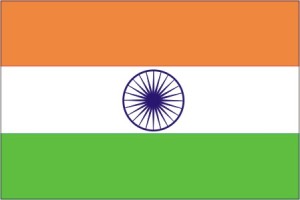
The Indian National Flag
India is one of the oldest civilizations in the world. It is a rough diamond shape with the northern and southern points about 2,000 miles apart.
It has one of the richest cultures in the world, and also very impressive landmarks, such as the Himalayas – the highest and youngest mountains in the world with many peaks rising to more than 20,000 feet. Mt. Everest, the highest mountain in the world, is in the Himalayas and lies partly in India, partly in Nepal and partly in Tibet. Yes, three whole countries.
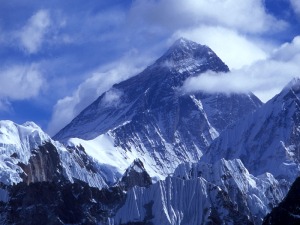
The stunning Mt. Everest in all its glory
India’s’ namesake is the Indus River, it being life-giving. Archaeologists have uncovered two ancient cities by the Indus River, called Harappa and Mohenjodaro. They were part of what we now call the Indus Valley Civilization, which was at its peak around 2500 B.C. The people in that area were dark-skinned, and known as the Dravidians. They are the earliest known occupants of this area.
Around 1500 B.C., light-skinned Aryans came from central Asia and and conquered all the land around the Indus River, forcing the darker-skinned Dravidians south. Even today, the northern and the southern Indians speak different languages and are lighter and darker skinned respectively.
The Dravidians of ancient Harappa and Mohenjodaro had systems of counting, measuring and writing, and was a considerably developed civilization. Even the cities were laid out in a geometric pattern!
They had indoor baths and toilets, both of which were connected to a sanitary sewage system with drains laid out underneath the roads. The ancient Dravidians were quite advanced in terms of cleanliness, inventing intricate and elaborate bathing systems in a time when soap was merely a distant thought (I’m sure soap was sacred to the sanitary freaks).
People don’t know for certain what it was, exactly, that led the two cities to ruins, but it is thought that serious water problems, such as repeated floods and droughts and the changing course of the river, contributed to wiping out the ancient people. Some historians believe the ancient people quite simply overused and exhausted the land, ruining the soil and effectively causing erosion. The people in the Indus Valley couldn’t survive without the basic necessities that the river provided, and, as a result, they perished.
The Indus Valley Civilization left behind a written language that so far, no one has managed to decrypt. If we manage to one day crack this mysterious language, we’ll probably be able to uncover more about what happened to this ancient civilization.
The Ancient Indian High School Musical-like Food Chain.
As well as kicking out the Dravidians, the Aryans took a society that was already divided tribally, and created a High School Musical-like food chain called castes.
There were four major castes, the highest consisted of the Brahmins, or priests and scholars. Next were the Kshatriyas, or the warriors and rulers. Then came the Vaishyas, or traders and merchants (or the People). Farmers, labourers and servants were the lowest caste, or the Shudras. Hitting rock bottom, were the untouchables—the pariahs or outcasts. They were the people who cleaned the streets, picked up dead animals, and did the other dirty jobs too lowly for anyone else.
However, unlike High School Musical, none of the castes would break out into a song. Ever. (Well, except maybe in Bollywood.)
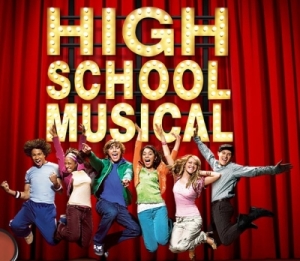
High School Musical!
Every one of the castes had ironclad rules. A member of one caste could not marry someone in a different caste. Eating a meal with someone from a lower caste, or even eating a meal prepared by someone from a lower caste was unheard of.
And as if the outcasts didn’t have it bad enough, their rules were the strictest. They were supposed to live outside of the village, and not mingle with the other castes. And that was why, they were called the ‘untouchables.’
Today, untouchability has been made forbidden by a law instituted by Mahatma Gandhi, who was one of India’s greatest leaders. While helping to modernise India he kindly renamed the outcasts Harijans or ‘People of God.’
Caste is no longer as influential as it once was, especially in the major Indian cities. But in the many villages scattered around India, caste is still an important part of life. In the villages life goes on just as it did hundreds of years ago and time stands still.
